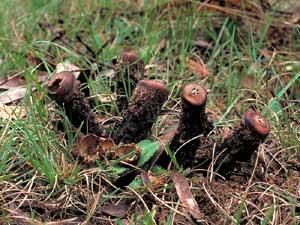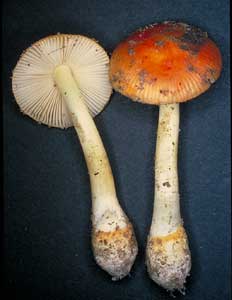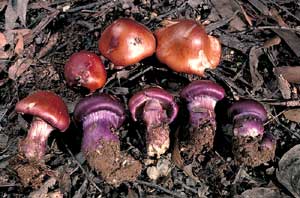Mycogeography
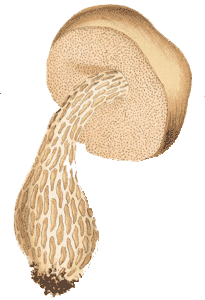 Australia
and nearby
Australia
and nearby
There are a number of fungi restricted to Australia's near neighbourhood - roughly the area bounded by Australia, New Zealand and Papua New Guinea. This may be due to the fact that, geologically speaking, these areas separated fairly recently or that the relative closeness of these countries allowed easy movement of species between them. In this section there will be a few examples of such fungi and then a short section on fungi endemic to Australia.
Species in the Australian neighbourhood
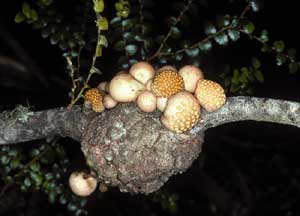 Cyttaria gunnii gall |
The Orange Golf-ball fungus, Cyttaria gunnii ![]() is found only in Australia and New Zealand, where it grows on Nothofagus trees,
usually from fungally-induced galls.
is found only in Australia and New Zealand, where it grows on Nothofagus trees,
usually from fungally-induced galls.
The genus Cyttaria provides an excellent example of a combination of
Gondwanan origin and host specificity. There are about a dozen species in the
genus Cyttaria and all grow only on Nothofagus, so that the various
species are found only in parts of Australasia and South America. Nothofagus
species are found in New Caledonia and Papua New Guinea, but no Cyttaria
species have ever been found in Papua New Guinea or New Caledonia - and not
for want of looking by experienced mycologists. There is an extensive fossil
record of Nothofagus pollen, with three different pollen types known.
The oldest pollen type in the fossil record is now found only in the Nothofagus
of Papua New Guinea and New Caledonia, leading some to call the plants in these
areas "living fossils". As the Nothofagus species in these
two areas are relicts of the ancestral stock, this implies that the ancestor
of all current Nothofagus species evolved before Cyttaria. While
seven Cyttaria species are known from South America, Cyttaria gunnii
is not one of them. At some stage the ancestral Gondwanan Cyttaria diverged
into an Australasian line and a South American line. Within the Australasian
line there was further species evolution with four species still found in Australasia
today. As already noted, of the four, Cyttaria gunnii is found in both
Australia and New Zealand. Cyttaria septentrionalis is found only in
Australia and Cyttaria nigra ![]() and Cyttaria pallida are restricted to New Zealand.
and Cyttaria pallida are restricted to New Zealand.
In some cases a particular Cyttaria species will grow only on a particular
Nothofagus species, while other Cyttaria species can grow on more
than one Nothofagus species. ![]() By
combining this knowledge with plate tectonics and the pollen history it is possible
to come up with a highly plausible co-evolutionary history of Nothofagus
and Cyttaria, which you can find in the reference
By
combining this knowledge with plate tectonics and the pollen history it is possible
to come up with a highly plausible co-evolutionary history of Nothofagus
and Cyttaria, which you can find in the reference
The Birds Nest fungus Cyathus novae-zealandiae ![]() and the flattish, disk-like fruiting bodies of the corticioid species Aleurodiscus
limonisporus
and the flattish, disk-like fruiting bodies of the corticioid species Aleurodiscus
limonisporus ![]() are found in south-east Australia and New Zealand. Peniophora crustosa
are found in south-east Australia and New Zealand. Peniophora crustosa
![]() ,
another corticioid species, is found in eastern Australia, New Zealand and Norfolk
Island. The invertebrate parasite Cordyceps gunnii
,
another corticioid species, is found in eastern Australia, New Zealand and Norfolk
Island. The invertebrate parasite Cordyceps gunnii ![]() is found growing in larvae of Oxycanus species in both Australia and
New Zealand - though it appears to have been collected only 2 or 3 times in
New Zealand.
is found growing in larvae of Oxycanus species in both Australia and
New Zealand - though it appears to have been collected only 2 or 3 times in
New Zealand.
The white to creamy fruiting body of Beenakia dacostae [www.hiddenforest.co.nz/fungi/family/gomphaceae/gomph04.htm] has a short stem and cap but under the cap there are spines rather than gills. It is a rare species found on tree fern trunks and on forest litter in wet forests of NSW, Victoria, Tasmania and NZ.. Beenakia dacostae was the first species of this genus to be discovered and the genus is named after the town of Beenak, in Victoria, where the type was collected. While this species has a restricted distribution, the genus is widespread and, interestingly, the other species are found in the tropical areas of Africa, India and America.
Pholiota multicingulata, a mushroom found on rotten wood of the family Myrtaceae, has been recorded from New Zealand, Tasmania and south-west Western Australia. Anthracophyllum archeri [http://www.deh.gov.au/biodiversity/abrs/publications/fungi/anthracophyllum-archeri.html]is found on the Australian mainland, Tasmania, Lord Howe Island and New Zealand.
Cortinarius rotundisporus [www.hiddenforest.co.nz/fungi/family/cortinariaceae/corti01.htm] is a mycorrhizal mushroom species, found in Eucalyptus and Nothofagus forests in New Zealand, NSW, Victoria, South Australia (south of Adelaide), Tasmania and south-west Western Australia. Dermocybe splendida [Fungimap Reference], another mycorrhizal mushroom, is found in much the same areas, associated with the family Myrtaceae.
Austroboletus lacunosus, (pictured in the Cooke painting at the top of this page) a mycorrhizal bolete, is found associated with Nothofagus or species of Myrtaceae in eastern Australia, New Caledonia and New Zealand. The polypore Australoporus tasmanicus (the only species in the genus Australoporus) is found in Victoria, Tasmania, New Zealand and Papua New Guinea, while the puffball relative Calostoma fuscum is found in Australia and New Zealand.
The large, funnel-shaped fruiting bodies of Cymatoderma elegans var.
lamellatum ![]() are found in tropical and sub-tropical Australasia as well as Fiji.
are found in tropical and sub-tropical Australasia as well as Fiji.
Endemic fungi
There is strong evidence to suggest that Australia has a significant level
of endemism in its fungal species. It is commonly accepted that mycorrhizal
fungi show a high level of endemism around the world. This is not too surprising.
In order to form a partnership there has to be some form of compatibility between
the fungal and plant partners. As different areas of the world have evolved
different vegetation types, it is reasonable to expect that these differences
in vegetation type have prompted the evolution of different species of associated
mycorrhizal fungi.
Amongst the Australian mycorrhizal mushrooms, this endemism is at the species
level - not at the generic level. For example, the mushroom genus Amanita
is found in all continents - and on each continent the genus is represented
by many species. However, the suite of Amanita species found in the eucalypt
forests of Australia is quite different to the Amanitas of the Nothofagus
forests of South America, the Amanitas of the coniferous forests of northern
Europe and so on. Two examples of endemic Amanita are Amanita xanthocephala
and the strikingly green Amanita austroviridis ![]() .
Cortinarius is another example of a worldwide, mycorrhizal mushroom genus
with many endemic Australian species, such as Cortinarius archeri .
.
Cortinarius is another example of a worldwide, mycorrhizal mushroom genus
with many endemic Australian species, such as Cortinarius archeri .
Australia has numerous endemic species of truffle-like fungi - and virtually all truffles are mycorrhizal. What is interesting is that not only is there a very high level of endemism at the species level but, in contrast to the mushrooms, a high proportion of endemic genera. (see TRUFFLE SECTION)
The sclerotium-forming polypore genus Laccocephalum ![]() contains five species, all of which are found in Australia. One of the five
has been found in New Zealand (but apparently introduced from Australia) and
another in Japan, so the genus is largely endemic to Australia.
contains five species, all of which are found in Australia. One of the five
has been found in New Zealand (but apparently introduced from Australia) and
another in Japan, so the genus is largely endemic to Australia.
Mycena viscidocruenta ![]() produces small, viscid mushrooms with caps to about 15mm in diameter. The original
description of the species was published in 1924 and was based on a specimen
collected near Sydney in 1914. The species is very common in many parts of eastern
Australia and is also found in New Zealand - but seemingly not as widespread
there and with sightings relatively recent when compared with the Australian
record. Given this evidence I assume that this is in fact an endemic Australian
species that has reached New Zealand relatively recently. Another endemic Australian
saprotroph is Marasmius elegans
produces small, viscid mushrooms with caps to about 15mm in diameter. The original
description of the species was published in 1924 and was based on a specimen
collected near Sydney in 1914. The species is very common in many parts of eastern
Australia and is also found in New Zealand - but seemingly not as widespread
there and with sightings relatively recent when compared with the Australian
record. Given this evidence I assume that this is in fact an endemic Australian
species that has reached New Zealand relatively recently. Another endemic Australian
saprotroph is Marasmius elegans ![]() ,
the 2-3 centimetre diameter caps often appearing in large numbers on forest
litter in south-east Australia and in the south-west of Western Australia.
,
the 2-3 centimetre diameter caps often appearing in large numbers on forest
litter in south-east Australia and in the south-west of Western Australia.
![]() The
ascomycete genus Banksiamyces is endemic to Australia. The four species
in the genus produce small, cup-shaped fruiting bodies on Banksia cones.
The
ascomycete genus Banksiamyces is endemic to Australia. The four species
in the genus produce small, cup-shaped fruiting bodies on Banksia cones.
Jafneadelphus ferrugineus ![]() is another example of a presumably endemic species which (like Mycena viscidocruenta)
has been found relatively recently in New Zealand. In Australia this species
has been collected many times since 1887. The New Zealand collection was made
in 2002.
is another example of a presumably endemic species which (like Mycena viscidocruenta)
has been found relatively recently in New Zealand. In Australia this species
has been collected many times since 1887. The New Zealand collection was made
in 2002.
Australia has endemic "twins" of various overseas species. For example,
the native Amanita austrophalloides (first reported in 1997, growing
amongst Casuarinaceae near Sydney) is macroscopically similar to the European
Amanita phalloides ![]() .
While the European species is the deadly Deathcap mushroom (see DEATHCAP
SECTION), nothing is known about the toxicity of the Australian species.
Another example is provided by Cortinarius austroviolaceus (published
as anew species in 2001), which is similar to the northern hemisphere Cortinarius
violaceus. These new Australian species are based on relatively recent,
fresh collections. It is inevitable that in Australian herbaria there will be
older collections that are in fact distinct Australian species, but which have
been given the names of various European or American species. In the nineteenth
and early twentieth century it was common to use northern hemisphere species
names for Australian fungi which looked much like species found in the northern
hemisphere. As much of the identification and classification work at that time
was based on macroscopic features, the use of those foreign names is understandable.
However, more careful study has shown that many fungi may be macroscopically
alike but microscopically quite distinct. Therefore, as more of the older Australian
herbarium collections are carefully re-examined, more endemic twins will be
discovered.
.
While the European species is the deadly Deathcap mushroom (see DEATHCAP
SECTION), nothing is known about the toxicity of the Australian species.
Another example is provided by Cortinarius austroviolaceus (published
as anew species in 2001), which is similar to the northern hemisphere Cortinarius
violaceus. These new Australian species are based on relatively recent,
fresh collections. It is inevitable that in Australian herbaria there will be
older collections that are in fact distinct Australian species, but which have
been given the names of various European or American species. In the nineteenth
and early twentieth century it was common to use northern hemisphere species
names for Australian fungi which looked much like species found in the northern
hemisphere. As much of the identification and classification work at that time
was based on macroscopic features, the use of those foreign names is understandable.
However, more careful study has shown that many fungi may be macroscopically
alike but microscopically quite distinct. Therefore, as more of the older Australian
herbarium collections are carefully re-examined, more endemic twins will be
discovered.
![An Australian Government Initiative [logo]](/images/austgovt_brown_90px.gif)


